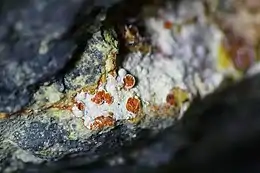Umohoite
Umohoite is a rare oxide and hydroxide mineral. The name of this mineral reflects its composition: uranyl (U), molybdate (Mo) and water (H2O). Its chemical formula is (UO2)MoO4·2H2O.[2]
| Umohoite | |
|---|---|
 | |
| General | |
| Category | Oxide and Hydroxide |
| Formula (repeating unit) | (UO2)MoO4·2H2O |
| Crystal system | Triclinic |
| Identification | |
| Color | Black, blue-black, dark green, orange-red [1] |
| Cleavage | Perfect on {001} |
| Mohs scale hardness | 2 |
| Luster | Vitreous |
| Streak | Blue gray |
| Diaphaneity | Opaque |
| Density | 4.53 - 4.66 g/cm3 (Measured) 4.49(3) g/cm3 (Calculated) |
| Refractive index | nα = 1.660 nβ = 1.831 nγ = 1.915 |
| 2V angle | Measured: 65° , Calculated: 64° |
| Other characteristics | |
Umohoide's type location is in Marysvale, the mineral was first described by Paul F. Kerr and G. P. Brophy in 1953.[3]
References
- F. Dal Bo, F. Hatert, S. Philippo (2018). "Supergene Uranyl Mineralization of the Rabejac Deposit, Lodève, France." Minerals, Volume 8, Issue 9.
- "Umohoite: Umohoite mineral information and data". mindat.org. Retrieved 2019-08-14.
- Brophy, G.P. & Kerr, P.F. (1953): Hydrous uranium molybdate in Marysvale ore. Annual Report June 30, 1952 - April 1, 1953 U.S.Atomic Energy Comm., RME-3046, 45-51.
This article is issued from Wikipedia. The text is licensed under Creative Commons - Attribution - Sharealike. Additional terms may apply for the media files.